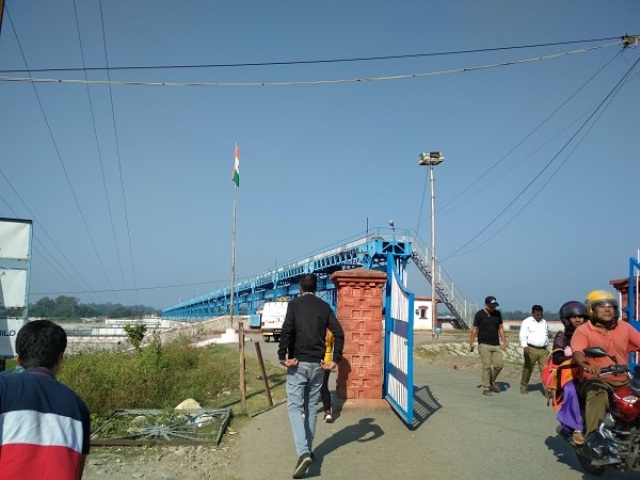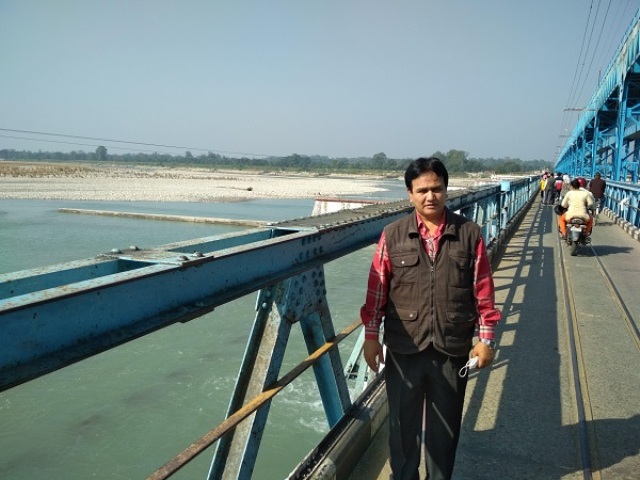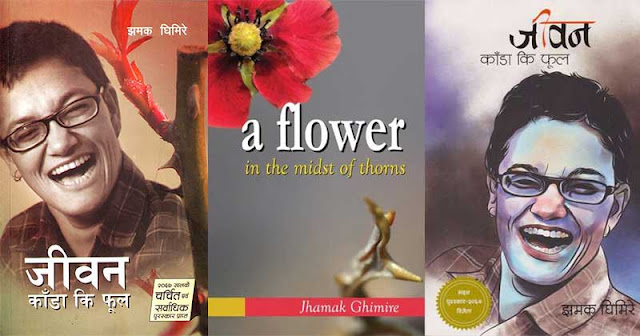CROSSING THE INDO-NEPAL BOARDER AT BANBASA-MAHENDRANAGAR
 |
| Indo-Nepal border at Barbasa, Mahendra Nagar. Photo: LB Thapa |
Unlike other Indo-Nepal borders, Barbasa-Mahendranagar
border is different---to know all that you should read the entire article
By LB THAPA, in Indo-Nepal border, Barbasa-Mahendranagar
I boarded a bus from Pokhara to Delhi that reached
Mahendranagar Indo-Nepal open boarder the next day morning at about 9 am. The
armed personnel of Boarder Security Force (BSF) were on duty. They directed the
bus to a place to park.
One of the custom officers along with an armed BSF
soldier got into our bus and asked every one of us to get down the bus, leaving
all our belongings on the bus. We were not allowed to carry even handbags.
The driver of the
bus told us to walk across the bridge and go on the other side of the boarder;
it was Barbasa, Indian side. All the passengers left the bus and began walking
towards the Sarda barrage. Sarada barrage is built on the Mahakali River, but
in India it is named the Sarada River. Meanwhile, the BSF police started
checking our luggage. While walking on our way towards the Sarada barrage, we
passed by the immigration checkpoint but no one asked us to show our
identities.
The border is
remained open almost all the time in a year, but gates on Sarda barrage are
opened during specific time in a day. The gates are opened at 6am to 8am; 10am
to 12noon; 2pm to 4pm; and 6pm to 7pm.
Everyday hundreds
of thousands of Nepali and Indian citizens cross this boarder. Many Nepali
people go to Barbasa and nearby towns in search of jobs. Delhi is just 400 km
away from this border, whereas Kathmandu is about 700 km away.
Many Nepali
citizens prefer to go to Delhi to find jobs because that is more accessible
than going to major Nepali cities. I stopped a group of Nepali people who were
on their way to Delhi and had some chat with them.
‘Lots of
development tasks do take place in Delhi area almost round the year. There is
no dearth of works. Foods and living expenditure are also quite affordable.
However, just opposite there is no guarantee of regular works in Nepal. On top,
things are also very expensive. As a result, it is very difficult to save money
in Nepal, but we can save more money in Delhi. The only problem is that Indian
police troubles us while crossing the border. The only way to get rid of them
is to give them money.
 |
| British used this train engine for the transportation at this place in 1920. Photo: LB Thapa |
‘Nepali police is
also no better than Indian police. Nepali police do also trouble us as they hold
our goods which we bring from India. They ask us VAT bills and other papers…but
in reality, they want money. Now we separate a sum of money and keep the money in
a separate pocket. Truth has it that without bribe you cannot escape from both
borders’, said Ram Baruwa and his friends who hailed from Baitadi and
Dadeldhura.
I walked across
the Sarada barrage and reached on the other side of the barrage. The gates were
still closed so that I had more time to explore the area. In the meantime, I
met one of the official persons who was stationed at the barrage.
‘The barrage was
constructed by the British in 1920. They wanted to connect Mahendranagar and
Banbasa by the barrage so that they could transport important minerals and
necessary goods through a train. A railway track now disused is still in a good
condition. The railway track passes through the middle of the barrage’, he
informed.
Interestingly
enough, the engine, which was used during 1920-1928, can still be seen here.
The engine is installed at the entrance of the barrage with a small description
about the train engine. The engine is in very good condition and so is railway
track.
I saw a small
board where it was written both in Hindi and in English “Photography is not
allowed”. However, I wanted to show such a beautiful, historical train engine
to my esteemed readers of Roaming Post. So, by stealing the eyes of the
officials, I managed to click one photo of the train engine which was used by
the British during 1920-1928.
It was 10 o’clock
in the morning and the gates were opened for two hours. I saw our bus was
trying to adjust its position to cross the gate. The gate was meant for small
size four wheelers, not for big size bus. But in India and Nepal many things
can be turned to our favor by giving bribe.
If you have a
hidden camera then a whole movie can be made here where policemen can be caught
pocketing bribes from the people of all walks of life. I am sure the film will
be a big hit and soon public will demand for its sequel.
Last but not the
least, there were two big holes in the front windscreen of our bus that you can
also see in the photo. Legally a bus in this condition cannot be driven on the
highway. But no problem, long live corruption! I saw the driver gave bribe to
Nepali traffic police and later to Indian traffic police in India...
Thank you very much
for reading this article. I hope you liked this article. I will be glad if you
take little time and make a comment about this article. Your comment is highly
appreciated.
LEGAL WARNING
All rights reserved. No
articles and photos published in this blog can be reproduced without the prior
written permission of the author. Legal action will be taken immediately if any
articles or photos are reproduced without the author’s knowledge. However,
articles or photos can only be reproduced by duly mentioning the author’s name
and the blog's name (read2bhappy.blogspot.com). The author must be informed by
sending an email. All articles and the photos published in this blog are the
copyright property of LB THAPA











.png)
Comments
Post a Comment